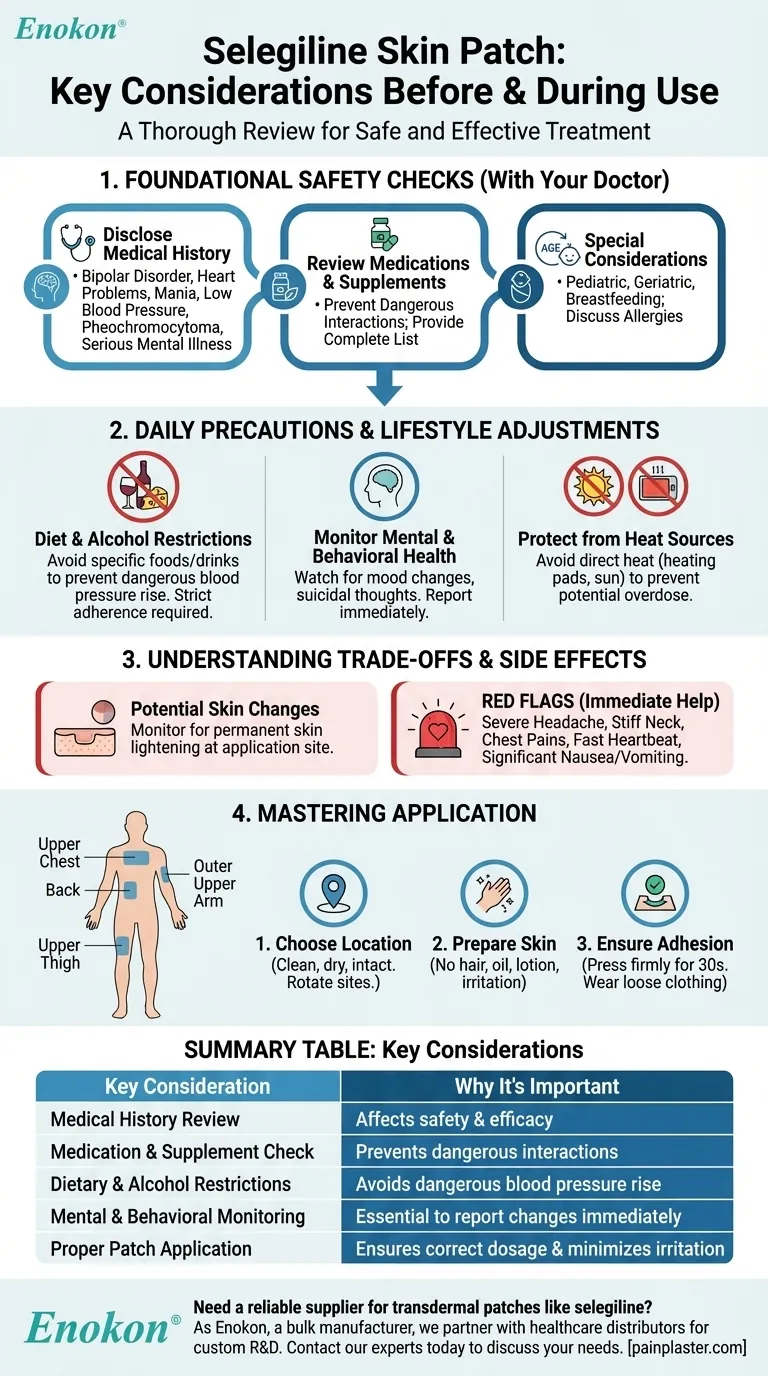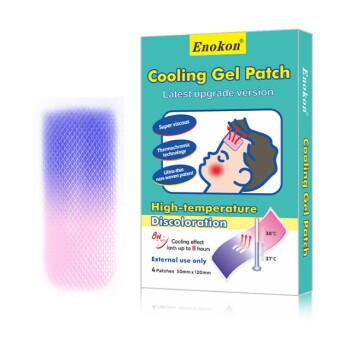Before using the selegiline skin patch, you must conduct a thorough review of your medical history, current medications, and lifestyle habits with your doctor. Key considerations include pre-existing conditions like heart problems or bipolar disorder, potential interactions with other drugs or certain foods, and the need for ongoing monitoring for both physical and behavioral side effects.
The core principle for using the selegiline patch is active partnership with your healthcare provider. Safe and effective treatment goes beyond just applying the patch; it requires your vigilance in monitoring dietary restrictions, mood changes, and physical reactions to prevent serious complications.

Foundational Safety Checks with Your Doctor
The most critical step happens before you ever apply the first patch. A transparent conversation with your doctor lays the groundwork for safe treatment.
Disclosing Your Full Medical History
You must inform your doctor about any history of specific medical conditions.
These conditions can significantly affect how selegiline works in your body and include bipolar disorder, heart problems, low blood pressure, a history of mania or hypomania, serious mental illness, and pheochromocytoma (a tumor of the adrenal gland).
Reviewing All Medications and Supplements
Drug interactions are a primary risk.
Provide your doctor with a complete list of all prescription medicines, over-the-counter drugs, and supplements you are taking. This is crucial for avoiding dangerous interactions.
Discussing Allergies and Sensitivities
Your doctor needs to know if you have ever had any unusual or allergic reaction to selegiline or similar medicines.
Special Considerations for Age and Pregnancy
Selegiline patch use requires special evaluation in certain populations.
This includes its use in pediatric or geriatric patients as well as for individuals who are currently breastfeeding.
Daily Precautions and Lifestyle Adjustments
Using the selegiline patch effectively means integrating specific precautions into your daily routine.
The Critical Role of Diet and Alcohol
You must avoid certain foods and alcoholic beverages while using the patch. Your doctor will provide a specific list, which is essential for preventing a dangerous rise in blood pressure.
Monitoring Your Mental and Behavioral Health
Stay vigilant for any behavioral changes or the emergence of suicidal thoughts. Report any concerning shifts in your mood or thinking to your doctor immediately.
Protecting the Patch from Heat
Do not expose the application site to direct heat sources like heating pads, electric blankets, or prolonged direct sunlight. Heat can increase the amount of medicine absorbed into your body, leading to a potential overdose.
Understanding the Trade-offs and Side Effects
Like any medication, the selegiline patch comes with potential risks and side effects that you must be prepared to manage.
Potential for Permanent Skin Changes
Over time, the patch may cause permanent skin lightening in the area where it is applied. You should monitor your skin and report any new areas of lighter skin to your doctor.
Red Flags Requiring Immediate Attention
Certain side effects signal a medical emergency and require you to seek help without delay.
These include a severe headache, stiff neck, chest pains, a fast heartbeat, or significant nausea and vomiting.
Mastering the Application Process
Proper application ensures you receive the correct dose and minimizes skin irritation.
Choosing the Right Location
Apply the patch to a clean, dry, and intact area of skin.
The recommended locations are the upper chest, back, upper thigh, or the outer part of the upper arm. Rotate application sites with each new patch.
Preparing the Skin
Avoid areas that are hairy, oily, irritated, scarred, or calloused. Do not apply lotions or creams to the area where you plan to place the patch.
Ensuring Proper Adhesion
Press the patch firmly onto your skin with the palm of your hand for about 30 seconds to ensure it is sealed. Wear loose clothing over the patch to avoid rubbing it off.
A Checklist for Safe and Effective Use
Use these points to guide your treatment journey in collaboration with your healthcare provider.
- If your primary focus is starting treatment safely: Ensure you have a complete and transparent conversation with your doctor about your entire health history and all current medications.
- If your primary focus is managing daily use: Adhere strictly to all dietary restrictions and be vigilant about monitoring for any changes in your mood or physical well-being.
- If your primary focus is avoiding complications: Know the signs of a serious reaction and have a plan to seek immediate medical help if they occur.
Ultimately, your active participation and awareness are the most important factors in a successful treatment outcome.
Summary Table:
| Key Consideration | Why It's Important |
|---|---|
| Medical History Review | Conditions like heart problems or bipolar disorder can affect safety and efficacy. |
| Medication & Supplement Check | Prevents dangerous drug interactions. |
| Dietary & Alcohol Restrictions | Crucial to avoid a dangerous rise in blood pressure. |
| Mental & Behavioral Monitoring | Essential to report any mood changes or suicidal thoughts immediately. |
| Proper Patch Application | Ensures correct dosage and minimizes skin irritation. |
Need a reliable supplier for transdermal patches like selegiline?
As Enokon, a bulk manufacturer of reliable transdermal patches and pain plasters, we partner with healthcare and pharma distributors and brands. Benefit from our technical expertise for custom R&D and development to ensure your products meet the highest standards of safety and efficacy.
Contact our experts today to discuss your specific needs and how we can support your product development.
Visual Guide

Related Products
- Far Infrared Deep Heat Relief Patches Medicated Pain Relief Patches
- Capsaicin Chili Medicated Pain Relief Patches
- Asthma Cough and Pain Relief Patch for Adults and Kids
- Far Infrared Pain Patch Relief Pain Reliever for Back
- Menthol Gel Pain Relief Patch
People Also Ask
- How quickly does the Deep Heat Pain Relief Back Patch activate and how long does it provide warmth? Get 16-Hour Relief
- How often should pain relief patches be used? Get the Right Schedule for Targeted Relief
- How do Deep Heat Pain Relief Patches provide pain relief? Discover the Drug-Free Mechanism
- What are pain relief patches and how are they used? A Guide to Safe, Targeted Relief
- How effective are pain relief patches for muscle pain? Target Localized Pain with Transdermal Delivery















